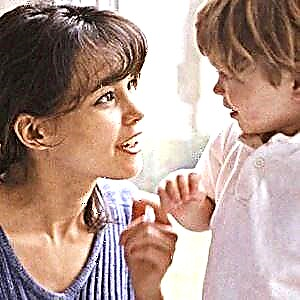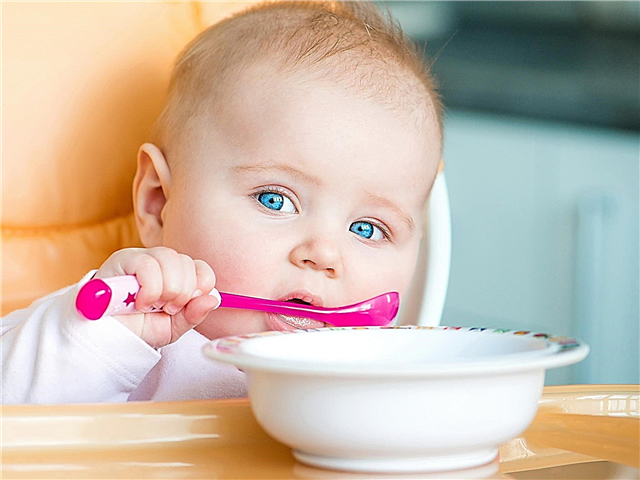Many parents have heard of such a concept as "crisis 3 years." However, all the same, the hysteria that occurs in three-year-olds, a negative attitude towards requests and wishes from adults take the latter by surprise.
Previously, a completely obedient kid suddenly begins to arrange "scenes", stomp his feet in an attempt to achieve what he wants. Sometimes the intensity of the crisis period is so high that parents reach for valerian to calm shattered nerves.
Meanwhile, psychologists are convinced that the crisis of three years is an obligatory stage in the life of every child, when he is separated from the adult and realizes himself as an independent unit. Therefore, you should not be afraid and, moreover, prevent growing up, but you should definitely help your baby to survive this period with maximum benefit.
What is a 3-year crisis?
 Wise nature does not tolerate static and unchanging phenomena, which is why literally everything that surrounds us is in constant development and movement.
Wise nature does not tolerate static and unchanging phenomena, which is why literally everything that surrounds us is in constant development and movement.
This rule can also be attributed to the child's psyche, which changes and becomes more complicated over time.
Periodically, in the process of mental development, crisis stages occur, which are characterized by the rapid accumulation of knowledge and skills and the transition to a higher level.
But above all, the crisis of three years is a breakdown and restructuring of social relations. The question of why it comes and what it is for is quite natural. Let's try to answer in a somewhat allegorical way.
A baby in a family of loving parents grows like a chick in an shell. The world around us is understandable, in the "shell" it is very comfortable and calm. However, such protection is not eternal, and there comes a certain period when it cracks.
The shell breaks, and the child realizes a curious thought: he can perform some actions himself and is able to do without even the help of his beloved mother. That is, the baby begins to perceive himself as an autonomous person who has desires and some opportunities.
American scientist Eric Erickson argued that the crisis of three years contributes to the formation of volitional qualities and independence in a child.
But, despite the desire to become more independent, kids are not yet competent enough, therefore, in many situations, adults simply cannot do without the help of adults. Thus, a contradiction arises between "I want" ("I myself") and "I can."
It is interesting that the main negative is directed at the closest people and, first of all, at the mother. With the rest of adults and peers, the baby can behave absolutely evenly. Consequently, it is the relatives who are responsible for the optimal way out of the baby from the crisis.
Age range of the crisis period
This stage of personality formation is only conventionally referred to as the "crisis of three years." The first symptoms of disobedience are sometimes noted as early as 18 - 20 months, but they reach their greatest intensity in the period from 2.5 to 3.5 years.

The duration of this phenomenon is also conditional and is usually only a few months. However, in the event of an unfavorable development of events, the crisis may drag on for a couple of years.
The severity of psychoemotional reactions, however, like the duration of the period, depends on characteristics such as:
- children's temperament (in choleric people, the signs appear brighter);
- parenting style (parental authoritarianism exacerbates the manifestations of child negativism);
- features of the relationship between mother and child (the closer the relationship, the easier it is to overcome negative moments).
Indirect conditions can also affect the intensity of emotional reactions. For example, it will be more difficult for a child to survive a crisis if the peak of the phenomenon falls on adaptation to kindergarten or the appearance of a younger brother or sister in the family.
7 main signs of the phenomenon
Psychology characterizes the crisis of 3 years as a seven-star symptom. These distinctive qualities help to accurately determine that the child has entered the time of independence from adults, and his emotionality is not the result of being spoiled or ordinary harmful.
Negativism
This manifestation must be distinguished from the elementary childish disobedience that occurs at any age. The behavior of a naughty child is conditioned by his desires, which do not coincide with parental requirements.
 In the case of negativism, babies abandon their own desires, even if they coincide with the requirements or suggestions of mom or dad. That is, children do not want to do something just because the initiative comes from a close adult.
In the case of negativism, babies abandon their own desires, even if they coincide with the requirements or suggestions of mom or dad. That is, children do not want to do something just because the initiative comes from a close adult.
Let's consider the differences with specific examples:
- a pattern of disobedience. The kid played on the street. Mom calls him to eat, but since he has not yet walked up, he refuses to enter the house. That is, the basis of his behavior is the desire to take a walk, contrary to his mother's demand to return home;
- an example of negativism. The kid playing on the street is called for lunch, but he is categorically against it, although he is already tired of walking and getting hungry. That is, the refusal is due not to a lack of playing time, but to the desire to resist mom, although their desires in this case coincide.
Thus, negative reactions are always targeted and directed not at the content of the request (requirements, wishes), but at a specific person. Usually the "object" is the mother.
There is no need to pressure the child or force him to perform the desired action. Let him "cool down" a little, and only then turn to him with a request. Alternatively, another family member, for example, dad, can act as the "negotiator".
Obstinacy
Obstinate behavior is somewhat reminiscent of negativism, but differs in impersonality, that is, it is directed not at a certain family member, but at the usual way of life.
We can say that in this way the child protests against all objects and orders that surround him.
 The psychology of young children is such that, with a greater degree of probability, obstinacy will manifest itself in those families where there are discrepancies about parenting and disciplinary measures between the mother and father, parents and the older generation.
The psychology of young children is such that, with a greater degree of probability, obstinacy will manifest itself in those families where there are discrepancies about parenting and disciplinary measures between the mother and father, parents and the older generation.
An obstinate child generally does not want to fulfill the requests and reasonable requirements of all adult household members, as if he does not even hear the speech addressed to him. For example, a toddler continues to play with blocks despite a request from Mom and Dad to put the toys in the basket.
If the child is not going to fulfill your request right now, try to divert his attention to another activity. After a while, for example, he will take away toys on his own or wash his hands, and you will not have to "stand above your soul."
Stubbornness
Stubborn behavior should not be confused with persistence. In the first case, the child stands his ground only because he has already demanded it before. Perseverance is a manifestation of will that allows children to achieve the desired goal.
Let's consider the difference between these qualities with specific examples:
- a model of persistence. The kid categorically refuses to go to the table until he completes the tower of cubes, which for some reason collapses all the time;
- a model of stubbornness. You call the kid to have breakfast, but he refuses, because before that he said that he was not hungry (although in fact he was hungry at the moment).
There is no need to persuade the child or, again, insist on your own. The best solution is to leave breakfast on the table and invite your baby to eat when he gets hungry.
Despotism
The child seeks by all means to force the parents to do what he needs, even if it is a momentary desire. That is, childish despotism can be called a kind of desire for power over the mother or father.
For example, a toddler may want his mother not to leave him for a minute. If there are several children in the family, then the child begins to show jealousy towards his brother or sister - he takes toys, does not want to go out together, secretly pinches, etc.
This behavior is an example of manipulation. Therefore, try not to follow the lead of a little despot, while showing that your attention can be attracted by peaceful means, without conflicts and hysteria.
Depreciation
At 3 years old, children often cease to appreciate everything that previously seemed very important to them.
 Moreover, this applies both to close people and to inanimate objects and rules of behavior.
Moreover, this applies both to close people and to inanimate objects and rules of behavior.
Before, it would seem, a well-mannered child begins to throw his favorite cars, rip off the dolls hands, tear out pages from books, it hurts to pull the cat's tail.
At this age, babies are often rude to those close people who previously enjoyed authority. For example, the baby can tell the grandmother that he will hit her, and the mother can be called a fool.
In addition, the vocabulary of three-year-olds is actively developing, so rude and even abusive words begin to appear in their vocabulary. Children actively use them to get a vivid negative reaction from their parents.
It is important to switch the child's attention to other toys - offer a typewriter instead of a doll. Regularly watch cartoons with your baby and read books on the rules of behavior with people, you can also play the situation in story games.
Willfulness
Children 3 years of age strive for maximum independence, it is not surprising that this period is also called the identity crisis "I myself". The kid is trying to get along on his own, regardless of the situation and his own disabilities.
Of course, it is good if the child, for example, tries to lace up shoes or put on a jacket himself. But it's a completely different matter when he pushes his mother's hand away when crossing the road or tries to turn on electronic devices without parental permission.
A child's independent behavior is the key to gaining valuable experience. Even if children do not succeed the first time, there will be an opportunity to learn from their mistakes. However, introduce prohibitions on those actions that can harm the child or other people.
Riot (protest)
Protest behavior is a child's reaction to pressure from important adults who demand to have breakfast at the same time, not shout in the street, not break toys, etc.

The result of parental diktat is a rebellion in the form of a refusal of habitual actions (the baby does not want to eat himself), hysteria, outbursts of anger and other negative manifestations.
Constant tantrums are not as easy as it might seem at first glance. Such reactions are a kind of stress that lead to malfunctions of the body's defense system. If the accumulated tension does not come out, auto-aggression occurs.
During protest "actions" try not to lose composure, listen to the child's opinion. If he rebel against security measures (wants to play with the ball on the road), do not follow the lead and do not change his mind.
Three-year crisis: rules for parents
First of all, mom and dad need to understand that such features of a child's behavior are not bad heredity or congenital harm. The little man is growing up and striving for greater independence, which means that you need to build a completely different format of relations with him.
A correct understanding of the meaning of the crisis of three years is also important because at this age the baby accepts his “I”, an initial self-esteem is formed in him, that is, a child's personality is born.
In order to smooth out the severity of negative manifestations of the crisis period as much as possible, adults should listen to several recommendations of experts:
 Give your child more independence. For example, involve him in household chores. At three years old, a boy and a girl can be entrusted with washing dishes (plastic), cleaning, laying out napkins, etc. The only exception applies to potentially dangerous activities - working with electrical appliances.
Give your child more independence. For example, involve him in household chores. At three years old, a boy and a girl can be entrusted with washing dishes (plastic), cleaning, laying out napkins, etc. The only exception applies to potentially dangerous activities - working with electrical appliances.- Keep calm. An overly emotional reaction of parents to the child's behavior will only strengthen his position and increase tantrums. If the mother looks calmly and without emotion at the screams and tears, the baby understands that his manipulation does not lead to the desired result. As a result, the behavior is stabilized.
- Reduce the number of inhibitions. There is no need to surround your child with numerous restrictions that only anger him. State the really important safety and social rules that are strictly prohibited. And in the little things you can and should give in.
- Let your child choose. To avoid conflict, you can cheat a little by asking your baby to choose from several options. For example, ask your daughter which dress she will wear to kindergarten: green or blue.
A baby at three years old does not always go against his parents, especially if he is not forced, but asked. Wise parents do not drag a resisting child across the road, but ask him to take himself by the handle and move him to the other side of the roadway.
Fighting tantrums
The third year of a child's life is the time for the appearance or intensification of hysterical reactions. The crisis of three years is increasing their intensity, so advice to parents on how to fight and prevent tantrums will come in handy.
- To prevent an emotional outburst, it is necessary to negotiate with the child in advance. For example, before visiting a toy store, agree on what to buy. Of course, this will not help in 100% of cases, but the likelihood of hysteria will be significantly reduced.
- In the midst of passion, one should not explain anything to the child. Wait for him to come to his senses, and then discuss why his behavior (but not him) seems bad and unworthy to you. Be sure to tell your baby about your feelings, even negative ones.
- In the event of a public hysteria, it is necessary to deprive the child of "spectators". To do this, you need to either take him to a less crowded place, or try to distract attention with a flying bird or a running dog.
Well, since the leading activity for three-year-olds is a game, all situations that lead to tantrums should be played. “Shop” with dolls, “feed” toys, play a trip to the clinic, etc.
Tantrums in a 3-year-old child occur quite often. The psychologist's recommendations will allow you to figure out what are the main reasons for such emotional behavior, how to prevent tantrums and how you can reduce the strength of these reactions.
Do these problems always arise?
Psychologists have proven that a three-year crisis is an obligatory and natural milestone in childhood growing up. However, the presence of the negative signs described above, or rather, their excessive severity, is an optional condition for the development of the child.

Sometimes the crisis period proceeds quite smoothly, without obvious symptoms and is characterized only by the emergence of certain personal neoplasms, among which:
- the child's awareness of his "I";
- talking about yourself in the first person;
- the emergence of self-esteem;
- the appearance of volitional qualities and perseverance.
As already noted, the crisis will be much milder if parents take into account the age and individual characteristics of the baby when choosing the optimal educational measures.
In general, three-year-olds are characterized by some common behavioral features, which are worth mentioning in more detail in order to take them into account when communicating with a baby:
- Children try to achieve the end result of their actions. For a three-year-old child, it is important to finish the job, be it drawing or washing dishes, so failures often do not stop him, but only stimulate him.
- The kid likes to demonstrate the obtained result to adults. That is why parents need to give positive assessments of the results of children's activities, because a negative or indifferent attitude can lead to negative self-perception in children.
- The emerging self-esteem makes the child touchy, dependent on other people's opinions and even boastful. Therefore, parents' inattention to childhood experiences can become a source of negative self-determination.
Thus, the emergence of one's own “I”, the ability to achieve one's own and dependence on the assessments of close people become the main results of the crisis of three years of age and mark the transition of the child to the next stage of childhood - preschool.
A 3-year-old crisis is not a reason to panic and consider your child bad and uncontrollable. All children go through this period, but it is in your power to make its course as painless and fruitful as possible for the baby. To do this, you just need to respect him as a person.

 Give your child more independence. For example, involve him in household chores. At three years old, a boy and a girl can be entrusted with washing dishes (plastic), cleaning, laying out napkins, etc. The only exception applies to potentially dangerous activities - working with electrical appliances.
Give your child more independence. For example, involve him in household chores. At three years old, a boy and a girl can be entrusted with washing dishes (plastic), cleaning, laying out napkins, etc. The only exception applies to potentially dangerous activities - working with electrical appliances.

